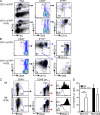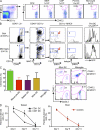Flt3L controls the development of radiosensitive dendritic cells in the meninges and choroid plexus of the steady-state mouse brain
- PMID: 21788405
- PMCID: PMC3149213
- DOI: 10.1084/jem.20102657
Flt3L controls the development of radiosensitive dendritic cells in the meninges and choroid plexus of the steady-state mouse brain
Abstract
Antigen-presenting cells in the disease-free brain have been identified primarily by expression of antigens such as CD11b, CD11c, and MHC II, which can be shared by dendritic cells (DCs), microglia, and monocytes. In this study, starting with the criterion of Flt3 (FMS-like receptor tyrosine kinase 3)-dependent development, we characterize the features of authentic DCs within the meninges and choroid plexus in healthy mouse brains. Analyses of morphology, gene expression, and antigen-presenting function established a close relationship between meningeal and choroid plexus DCs (m/chDCs) and spleen DCs. DCs in both sites shared an intrinsic requirement for Flt3 ligand. Microarrays revealed differences in expression of transcripts encoding surface molecules, transcription factors, pattern recognition receptors, and other genes in m/chDCs compared with monocytes and microglia. Migrating pre-DC progenitors from bone marrow gave rise to m/chDCs that had a 5-7-d half-life. In contrast to microglia, DCs actively present self-antigens and stimulate T cells. Therefore, the meninges and choroid plexus of a steady-state brain contain DCs that derive from local precursors and exhibit a differentiation and antigen-presenting program similar to spleen DCs and distinct from microglia.
Figures






References
-
- Bailey S.L., Carpentier P.A., McMahon E.J., Begolka W.S., Miller S.D. 2006. Innate and adaptive immune responses of the central nervous system. Crit. Rev. Immunol. 26:149–188 - PubMed
-
- Bartholomäus I., Kawakami N., Odoardi F., Schläger C., Miljkovic D., Ellwart J.W., Klinkert W.E., Flügel-Koch C., Issekutz T.B., Wekerle H., Flügel A. 2009. Effector T cell interactions with meningeal vascular structures in nascent autoimmune CNS lesions. Nature. 462:94–98 10.1038/nature08478 - DOI - PubMed
Publication types
MeSH terms
Substances
Grants and funding
LinkOut - more resources
Full Text Sources
Other Literature Sources
Molecular Biology Databases
Research Materials
Miscellaneous

